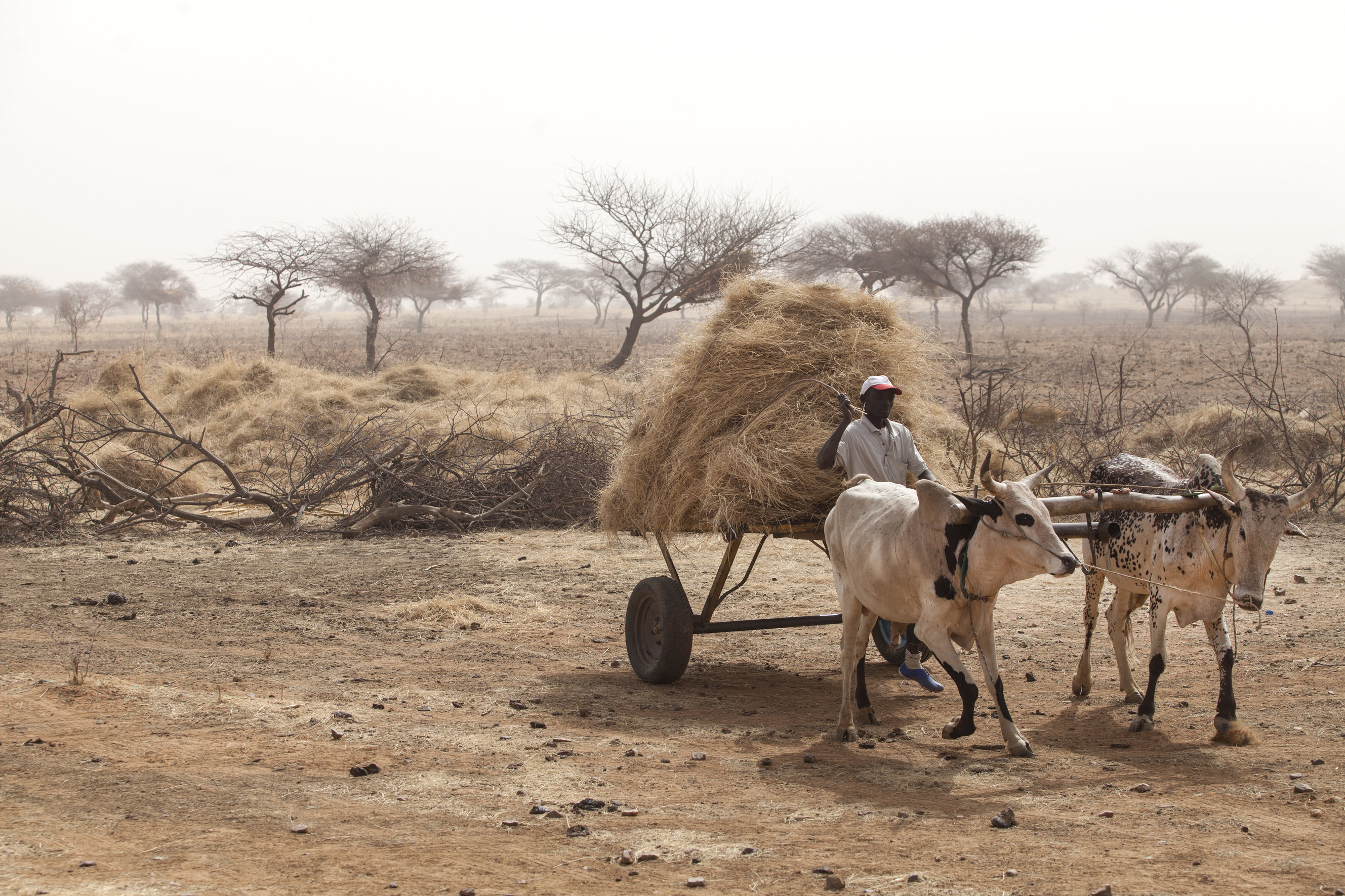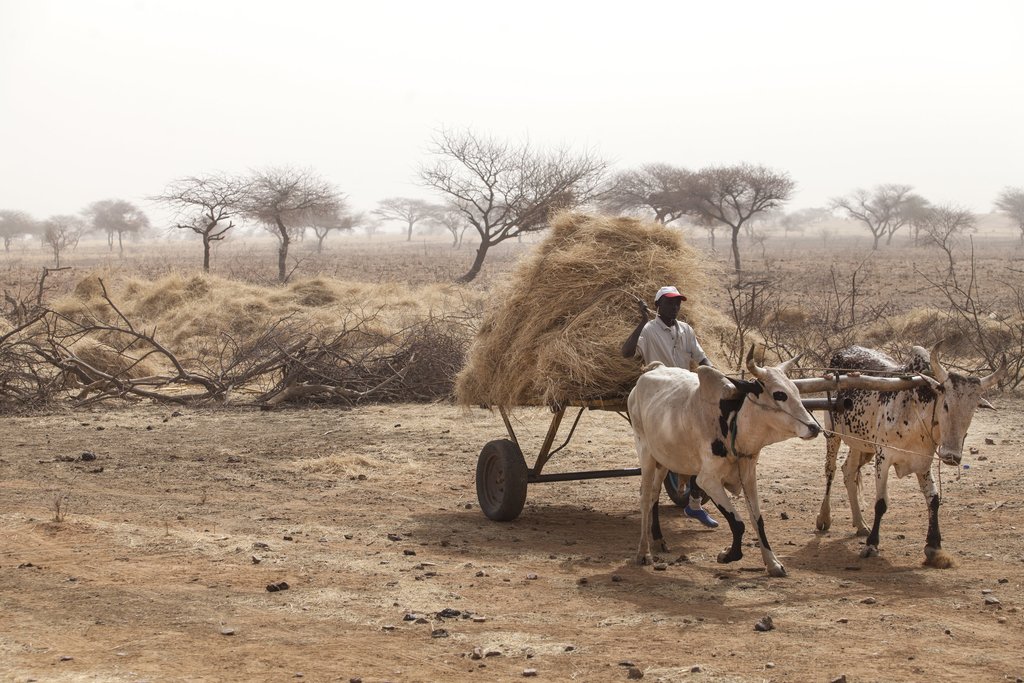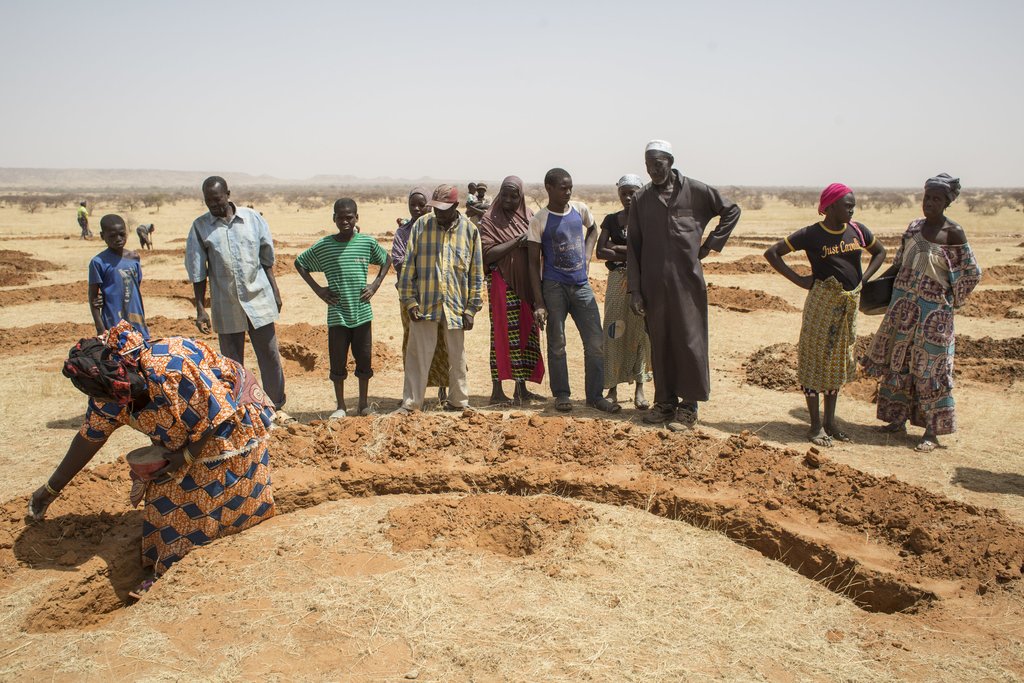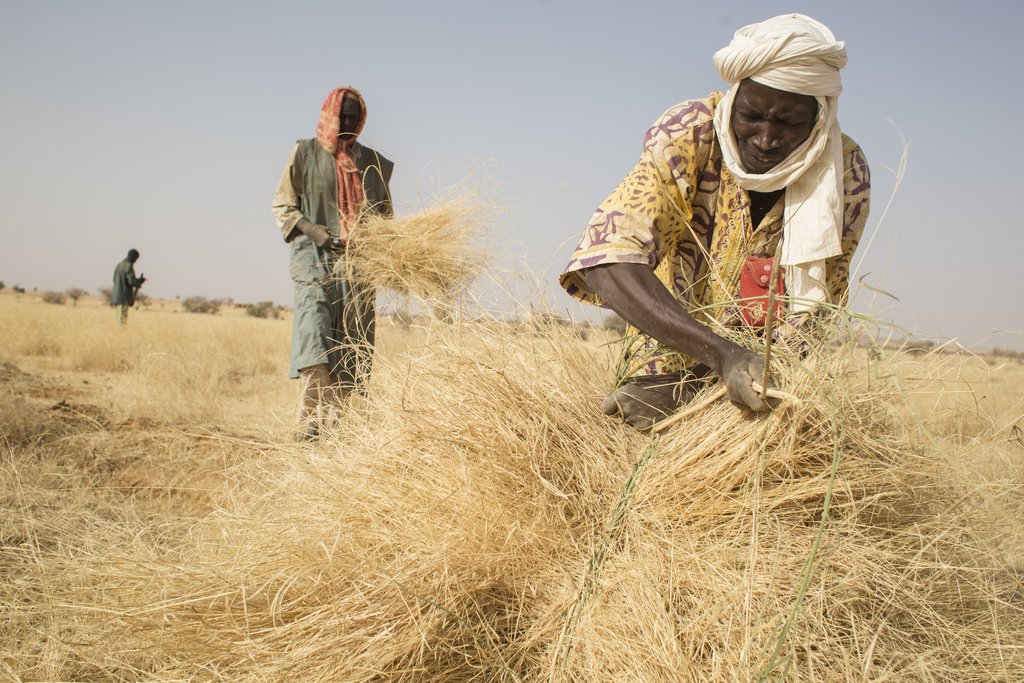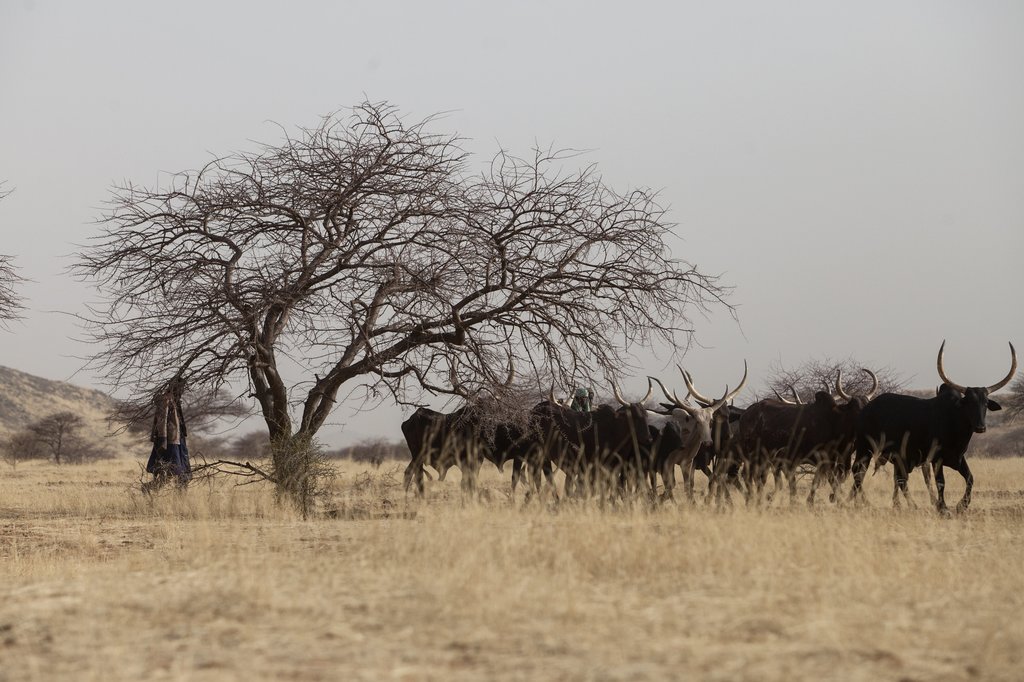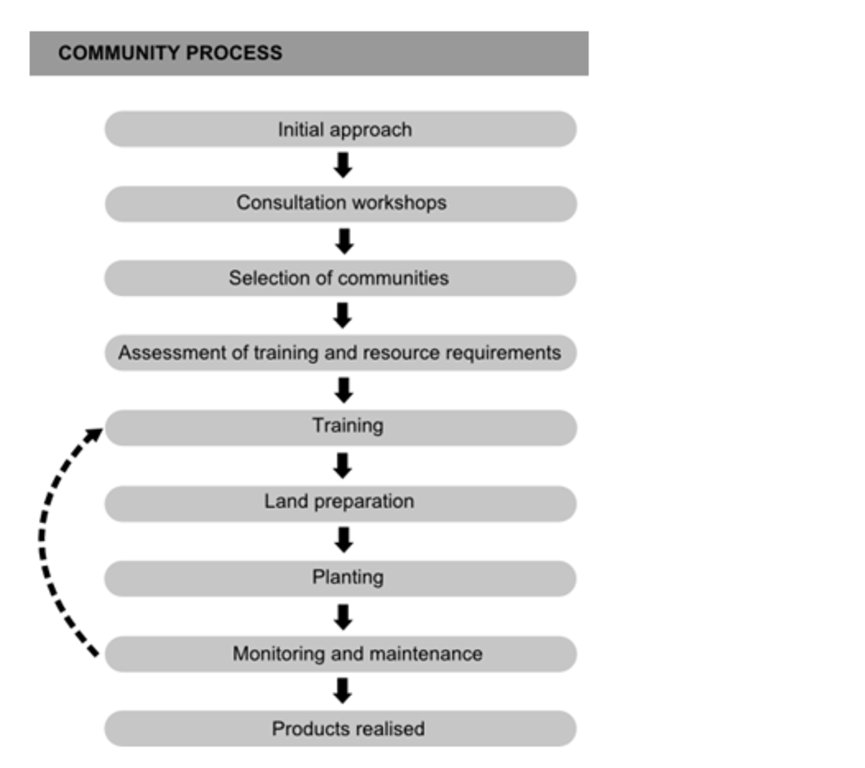Community participation in large-scale land restoration for Africa’s Great Green Wall programme [النيجر]
- تاريخ الإنشاء:
- تحديث:
- جامع المعلومات: Vivian Onyango
- المحررون: Vivian Onyango, Moctar Sacande
- المراجعون: Rima Mekdaschi Studer, Simone Verzandvoort, Donia Mühlematter
approaches_2909 - النيجر
- Community participation in large-scale land restoration for Africa’s Great Green Wall programme: 2 نوفمبر، 2021 (inactive)
- Community participation in large-scale land restoration for Africa’s Great Green Wall programme: 4 يوليو، 2018 (inactive)
- Community participation in large-scale land restoration for Africa’s Great Green Wall programme : 13 مايو، 2018 (inactive)
- Community participation in large-scale land restoration for Africa’s Great Green Wall programme : 26 إبريل، 2018 (inactive)
- Community participation in large-scale land restoration for Africa‘s Great Green Wall programme in Niger.: 24 إبريل، 2018 (inactive)
- Community participation in large-scale land restoration for Africa’s Great Green Wall programme: 21 أغسطس، 2024 (public)
عرض الأقسام
توسيع الكل طي الكل1. معلومات عامة
1.2 تفاصيل الاتصال بالأشخاص الرئيسيين لمصدر المعلومات والمؤسسات المعنية بتقييم وتوثيق النهج
متخصص في الإدارة المستدامة للأراضي:
Sacande Moctar
moctar.sacande@fao.org
Forestry Policy and Resources Division (FOA)
إيطاليا
اسم المشروع الذي سهّل توثيق/تقييم النهج (إذا كان ذلك على صلة)
FAO-Action Against Desertificationاسم المؤسسة (المؤسسات) التي سهلت توثيق/تقييم النهج (إذا كان ذلك على صلة)
Food and Agriculture Organization of the United Nations (FAO) - إيطاليا1.3 الشروط المتعلقة باستخدام البيانات الموثقة من خلال WOCAT
يوافق جامع المعلومات والشخص (لاشخاص) الرئيسي لمصدر المعلومات على الشروط المتعلقة باستخدام البيانات الموثقة من خلال WOCAT:
نعم
2. وصف نهج الإدارة المستدامة للأراضي
2.1 وصف موجز للنهج
The Food and Agriculture Organization of the United Nations (FAO) has been using a participatory approach to implement large-scale restoration of degraded land in the Sahel. Communities have been central to the programme. In the framework of the Great Green Wall initiative, adapted and useful native tree species, shrubs, and fodder grasses are planted in agro-sylvo-pastoral land. This is response to community needs and preferences while ensuring that the species and varieties are all ecologically suitable.
2.2 وصف تفصيلي للنهج
وصف تفصيلي للنهج:
The approach is implemented under FAO's Action against Desertification (AAD) programme in the Great Green Wall for the Sahara and the Sahel Initiative (GGWSSI). This is Africa's flagship initiative to combat the effects of climate change and desertification, and to address food insecurity and poverty. It brings together more than 20 African countries with international agencies, research institutes, civil society and grassroots organizations. Through the GGWSSI, the vision is a mosaic of sustainable land use practices and productive landscapes stretching across North Africa, the Sahel and the Horn.
Community participation in the Great Green Wall restoration initiative is through a people-centred approach to rangeland management that puts communities at the heart of efforts. It focusses on plant species that support their livelihoods. Specifically these are a selection of well-adapted indigenous trees, shrubs and fodder grasses with proven resilience to drought and usefulness in restoration. Village communities decide on which areas to plant and on the species that they can utilise for food, for fodder, and for medicines. There are also plants that produce economically valuable goods for local, national and even international markets, such as gum arabic (from Acacia senegal) for example.
Technically, AAD supports the implementation of land restoration activities through provision of equipment, and by strengthening the technical and functional capacities of individuals, communities, and organizations in restoration techniques and sustainable land management.
The three main objectives of this approach are:
a) Poverty alleviation;
b) Ending hunger; and
c) Improving resilience to climate change.
The restoration approach is based on a five-step model:
• Communities: needs and requirements for restoration are determined through in-depth consultations with communities.
• Research: good quality seed is made available for the propagation of economically viable, locally adapted and biodiverse vegetation.
• Operational procedure: efficient operational restoration processes are ensured, including land preparation and management, assisted natural regeneration and planting.
• Monitoring: field performance of species are evaluated, as well as communal activities such as maintenance and management of restored areas.
• Capacity development: village technicians’ capacities are upgraded in forest seed collecting and nursery techniques, planting, maintenance and management of restored areas, and development of plant products, marketing, and local business management.
2.3 صور عن النهج
ملاحظات عامة بخصوص الصور:
The photos were taken under the FAO project GCP/INT/157/EC: Action Against Desertification is an initiative of the African, Caribbean and Pacific Group of States (ACP) to promote sustainable land management and restore drylands and degraded lands in Africa, the Caribbean and the Pacific, implemented by FAO and partners with funding from the European Union in the framework of the 10th European Development Fund (EDF).
2.4 فيديوهات عن النهج
تعليقات، وصف موجز:
https://www.youtube.com/watch?v=qVcMSeXZnJI
Over the next decade, 50 million people may be displaced by desertification - the result of climate change and the depletion of natural resources. Action Against Desertification, an initiative of the African, Caribbean, and Pacific Group of States is implemented by the Food and Agriculture Organization of the United Nations with the financial contribution of the European Union. It aims to restore the productivity of degraded forests and landscapes and enhance the resilience of people to climate change in 6 Great Green Wall countries in Africa as well as Haiti in the Caribbean and Fiji in the Pacific.
التاريخ:
02/12/2015
الموقع:
Rome
اسم مصور الفيديو:
© FAO
تعليقات، وصف موجز:
https://www.youtube.com/watch?v=prl1eaSvQCQ&feature=youtu.be
Land restoration in the Sahel is making degraded areas productive again, providing economic opportunities in a region where migration has become a tradition. Under FAO’s “Action Against Desertification” programme, these efforts are being expanded to six African countries. Land degradation around the Sahara is not yet irreversible.
التاريخ:
18/07/2016
الموقع:
Rome
اسم مصور الفيديو:
© FAO
2.5 البلد/المنطقة/المواقع التي تم تطبيق النهج فيها
البلد:
النيجر
المنطقة/الولاية/المحافظة:
Tillabery, Dosso and Tahoua
مزيد من التفاصيل حول الموقع:
In Niger, the GGWSSI covers all the eight regions of the country. Currently FAO’s Action Against Desertification project works in the three regions of Tillabery, Dosso and Tahoua, though the approach is expanding to the remaining five regions.
التعليقات:
The AAD land restoration approach has been successfully implemented with trans-boundary interventions in Niger, Burkina Faso, and Mali. For this documentation, the focus is on Tera, Niger.
Map
×2.6 تواريخ بدء وإنهاء تنفيذ النهج
أشر إلى سنة البدء:
2013
في حالة عدم معرفة السنة بالتحديد، يرجى الإشارة إلى التاريخ التقريبي لبدء النهج:
منذ أقل من 10 سنوات (مؤخرًا)
2.7 نوع النهج
- قائم على مشروع/برنامج
2.8 الغايات/الأهداف الرئيسية للنهج
Key elements and aims of this approach include:
• Planting the right species in the right place.
• Promoting the use of quality native forest and fodder seeds for restoration.
• Ensuring that a wide range of useful plant species is made available.
• Managing natural regeneration of species and planted areas through village management committees.
• Updating a species database for gene-pool traceability, monitoring, reporting and for future uses of data and information.
2.9 الظروف التي تمكن أو تعيق تنفيذ التقنية/التقنيات المطبقة بموجب النهج
المعايير والقيم الاجتماعية /الثقافية/ الدينية
- تمكين/تمكيني
The approach is people-centred, and builds on traditional management of land, traditional ecological knowledge and techniques such as “half-moons” (demi-lunes in French) for rainwater harvesting that facilitate improved plant establishment.
توفر/الوصول إلى الموارد والخدمات المالية
- تمكين/تمكيني
Individuals can acquire finance to buy seeds. On community land, finance may be needed to lease land for production of plant varieties, or for hiring labour to take care of seedlings.
الإطار المؤسساتي
- تمكين/تمكيني
Better organization at local level enhances community participation and commitment to achieve interventions at large-scale/community level.
التعاون/التنسيق بين الجهات الفاعلة
- تمكين/تمكيني
There are various levels of collaboration needed for example in establishing which land should/ can be used, in seed selection based on defined needs, and also for the provision of labor. Fundamentally, collaboration is key to agreements to achieve the desired objectives.
الإطار القانوني (حيازة الأراضي، وحقوق استخدام الأراضي والمياه)
- تمكين/تمكيني
Securing access rights to land and water resources is a motivation for investing in reforestation.
السياسات
- تمكين/تمكيني
National level policies can protect and ensure supply of seeds as well facilitate access to natural resources such as land. Additionally, policies such as those in support of Great Green Wall activities create an enabling environment within which these activities can be supported.
حوكمة الأراضي (صنع القرار والتنفيذ والإنفاذ)
- تمكين/تمكيني
Similar to legal framework above.
المعرفة حول الإدارة المستدامة للأراضي، والوصول إلى الدعم الفني
- تمكين/تمكيني
Knowledge around SLM contributes to maintenance and management of restored areas, thus ensuring sustainability of activities. The programme has integrated existing/traditional SLM activities such as zaï (wide planting pits)/half-moons in capturing, concentrating and storing water thus keeping soils moist and improving the chances of good plant growth in a very dry environment.
الأسواق (لشراء المدخلات وبيع المنتجات) والأسعار
- تمكين/تمكيني
Market access and increasing economic capacities of communities can enable active involvement in restoration especially when plant products can earn income thus facilitating local business.
عبء العمل، توفر القوى العاملة
- تمكين/تمكيني
Availability of labor facilitates activities such as forest seed collecting, nursery activities, planting, maintenance and management of restored areas. Most of the work is done by women who prepare the land and take the lead in planting.
3. المشاركة وأدوار الأطراف المعنية
3.1 أصحاب المصلحة المعنيون بالنهج وأدوارهم
- مستخدمو الأراضي المحليون/المجتمعات المحلية
Total project beneficiaries are currently 116,000 people (over half are women) Age varies from 15 to 70 years. Participants are villagers including farmers, herders, traditional healers and herbalists. Each intervention village has a village management committee set up for GGW implementation. They contribute land and labour, and village technicians are trained in large-scale degraded land restoration techniques so that they can be self-sufficient at the end of the funding.
1. Defining needs, preferences of species and objectives for land restoration in degraded areas. 2. Trained in the collection of seeds and in how to produce seedlings in village nurseries. 3.The communities involved also participated in the regular monitoring and evaluation of plots. 4. Participating in workshops including agreeing on work plans 5. Communities were also a source of rich traditional ecological knowledge 6. Supporting projects through in-kind contributions of labour and land 7. Representation in the steering committee
- المنظمات المجتمعية
Each intervention village has a village management committee set up for GGWSSI activities.
- Contributed land, labor and village technicians to be trained in large-scale land restoration techniques geared to self-sufficiency at the end of project life. Managing intervention sites including products such as fodder. Collaborating with national and local administrations.
- متخصصون في الإدارة المستدامة للأراضي / مستشارون زراعيون
Support in identification of land needed for restoration, seeds, and management of restoration.
- الباحثون
National seed centres.
1. Address the availability of good quality seeds for collection.
2. Ensure genetic diversity reflecting varieties of native species.
- منظمة غير حكومية
Local NGOs and CBOs.
Local NGO's were trained in land restoration activities.
NGOs were also instrumental in discussions on scaling up the approaches and policy support for mainstreaming sustainable land management.
- القطاع الخاص
Supplies of equipment and materials needed for restoration activities.
Mainly business related to procurement of goods and services.
- الحكومة المحلية
Local administration and national governments in the respective countries.
1. Provide technical management and management of the operational team.
2. Mobilization of communities.
3. Part of the steering committee.
- الحكومة الوطنية (المخططون، صانعو القرار)
1. Ministry of Environment and Sustainable Development.
2. National Agency of the Great Green Wall.
3. National Forestry Seed Centre.
4. Local authorities (i.e.Town halls/ Mairies in French) involved in Tillabery, Dosso and Tahoua regions.
- منظمة دولية
Royal Botanical Garden, Kew.
Technical support; botanical knowledge and information resources, and identifying priority species for the Great Green Wall.
3.2 انخراط مستخدمي الأراضي المحليين/المجتمعات المحلية في المراحل المختلفة للنهج
| انخراط مستخدمي الأراضي المحليين/المجتمعات المحلية | حدد من شارك وصف الأنشطة | |
|---|---|---|
| المبادرة/التحفيز | تفاعلي | Communities’ local knowledge, needs and aspirations were the backbone of the project. Communities were extensively consulted on species identification and prioritization based on needs, including speed of production, personal knowledge and aspirations. This was through questionnaires and village workshops. Commitment and buy-in from the community was also a prerequisite for activities to start, as they had to commit to contribute land and in-kind labour. Selection of villages for restoration was based on, amongst other things, motivation and commitment by communities to participate in restoration activities, and community-based structures and organizations. |
| التخطيط | تفاعلي | Extensive planning was done with communities before implementation, e.g. to agree on planting times, use of traditional techniques and land preparation. |
| التنفيذ | تفاعلي | Implementation was done actively with communities who volunteered traditional knowledge as well as labour to the activities. This built on the initial procedures where species were selected and prioritized; planning of activities; and later labour in preparation of land, setting-up nurseries and transplanting. |
| الرصد/التقييم | تفاعلي | Monitoring and field data collection of survival and growth of seedlings were carried out by trained village technicians in collaboration with the communities and technical institutions. |
3.3 مخطط التدفق (إذا كان متاحًا)
3.4 اتخاذ القرار بشأن اختيار تقنية/تقنيات الإدارة المستدامة للأراضي
حدد من الذي قرر اختيار التقنية/التقنيات التي سيتم تنفيذها:
- جميع الجهات الفاعلة ذات الصلة، كجزء من نهج تشاركي
اشرح:
This is a local initiative that uses traditional ecological knowledge and multi-purpose plant species (of known benefits to the local communities) for restoration.
Community participation, lifestyles and preferences and a careful analysis of ecological landscapes are carefully considered and then matched to suitable interventions. This similar approach has been applied by other projects in the GGWSSI region however although has not often been formally disseminated to wider audiences.
حدد على أي أساس تم اتخاذ القرارات:
- تقييم المعرفة الموثقة جيدًا بشأن الإدارة المستدامة للأراضي(اتخاذ القرارات القائمة على الأدلة)
- نتائج البحوث
- خبرة وآراء شخصية(غير موثقة)
4. الدعم الفني وبناء القدرات وإدارة المعرفة
4.1 بناء القدرات/التدريب
هل تم تقديم التدريب لمستخدمي الأراضي / الأطراف المعنيين الآخرين؟:
نعم
حدد من تم تدريبه:
- مستخدمو الأراضي
- موظفون ميدانيون/ مستشارون
إذا كان ذلك على صلة، حدد الجنس والعمر والوضع والعرق وما إلى ذلك.
100 small-scale farmers were trained in 2017, in Natural Assisted Regeneration techniques and 40 farmers were trained in forest and fodder seed collection and the production of seedlings in village nurseries and in the management of planted sites.
شكل التدريب:
- دورات
المواضيع المغطاة:
Technical training was provided to villages through formal modules in how to collect quality seeds in defined seed zones. The training was provided by the national forest seed centres. The training was in seedling production and participatory forest management. Other areas covered included; added-value and the development of plant products (non-timber forest products), marketing and local business management to support income generation.
التعليقات:
Apart from the restoration technical areas covered above, additional areas of training included; improving adult literacy, family health and nutritional standards. This was done together with specialized rural sector developers.
4.2 خدمة استشارية
هل يملك مستخدمو الأراضي وصولا إلى خدمة استشارية؟:
نعم
حدد ما إذا كانت الخدمة الاستشارية متوفرة:
- في حقول مستخدمي الأراضي
- في مراكز دائمة
- workshops
وصف/تعليقات:
To re-introduce plants for large-scale restoration, effective use of seeds of wild species demands sufficient biological and technical knowledge about a large number of species to allow for collection, storage and germination of seeds and establishment of seedlings. In this approach therefore, use was made of the technical know-how of RBG Kew and their partnership with forest seed centres that guided collection of quality seeds.
4.3 تعزيز المؤسسات (التطوير التنظيمي)
هل تم إنشاء أو تعزيز مؤسسات من خلال هذا النهج؟:
- نعم، إلى حد كبير
حدد المستوى (المستويات) التي تم فيها تعزيز أو إنشاء المؤسسات:
- محلي
- إقليمي
- وطني
صف المؤسسة والأدوار والمسؤوليات والأعضاء وما إلى ذلك.
Institutions: National government; NGOs, CBOs.
Support to the national government which is the national agency for the GGW is the entry point. Through them and based on national objectives, the project progresses to a decentralized level. At the national level, capacities have been improved on monitoring and evaluation techniques; seed identification and selection and handling.
Local level: these are the implementing partners and work on the ground. Their capacities have been improved on seed selection and restoration techniques, and on data collection
Regional level: more collaboration, coordination and knowledge sharing on the GGW initiatives as well as peer-to-peer learning.
حدد نوع الدعم:
- مالي
- بناء القدرات/التدريب
- معدات
اعط مزيدا من التفاصيل:
Equipment: mainly for land preparation for planting and non-timber forest product processing.
4.4 الرصد والتقييم
هل يشكل الرصد والتقييم جزءا من النهج؟:
نعم
التعليقات:
Regular monitoring is carried out by village communities involved in the restoration exercise. The activities include assessing seedling survival and growth, and the area planted.
إذا كانت الإجابة بنعم، فهل من المقصود استخدام هذه الوثائق للمراقبة والتقييم؟:
كلا
4.5 البحوث
هل كانت البحوث جزءًا من النهج؟:
نعم
حدد المواضيع:
- علم الاجتماع
- الاقتصاد / التسويق
- علم الايكولوجيا
أعط تفاصيل إضافية وأشر إلى من قام بالبحوث:
Through a questionnaire, communities define their needs and preferences for species, and the objectives of land restoration in their selected agro-sylvo-pastoral degraded lands. Results of this consultation are fed back to them after analyses by the project team (researchers, plant experts, seed centres) for the feasibility, suitability and availability of the requested species. This creates common agreement on interventions, priorities and implementation plans, with roles and responsibilities from the communities as well as from the technical teams.
1. Sociology: prior research was done on social diversity of village communities in areas such as gender, age, and professions to decide on village selection, but also to ensure balance.
2. Economics/marketing: this was multi-faceted - on the one hand looking at community economic needs and priorities, but also on how to add value to non-timber forest products. The plant-use data received from respondents were classified according to the Economic Botany Data Collection.
These helped in deciding and prioritizing species according to community needs.
3. Ecology: the GGW initiative is typically aimed at drylands with challenges of aridity. Thus the ecology was studied to identify suitable plant species that would thrive under these conditions - in combination with traditional SLM/ water harvesting technologies that have been developed to overcome moisture deficits.
The selected species was further examined in laboratories to check their suitability for dryland environments and thereafter to ensure good quality and genetically diverse seeds are used.
5. التمويل والدعم المادي الخارجي
5.1 الميزانية السنوية لمكون الإدارة المستدامة للأراضي في النهج المذكور
إذا لم تكن الميزانية السنوية الدقيقة معروفة، قم بالإشارة إلى نطاقها:
- 1,000000-100،000
التعليقات (على سبيل المثال المصادر الرئيسية للتمويل/الجهات المانحة الرئيسية):
Action Against Desertification is implemented by FAO and partners with funding from the European Union in the framework of the 10th European Development Fund (EDF). The GGWI under AAD in Niger is funded up to around 1.5m USD for the four years of the project.
5.2 الدعم المالي/المادي المقدم لمستخدمي الأراضي
هل حصل مستخدمو الأراضي على دعم مالي/ مادي لتنفيذ التقنية/ التقنيات؟:
نعم
إذا كانت الإجابة بنعم، حدد نوع (أنواع) الدعم والشروط والمزودين:
Finances are needed for purchasing equipment; seeds were also provided; seed testing was carried out to establish appropriate type/species of those chosen by the communities.
5.3 إعانات لمدخلات محددة (بما في ذلك العمالة)
- عمالة
| إلى أي مدى | حدد الإعانات |
|---|---|
| ممول جزئيا | Local communities shared some tasks such as during planting period the project provided lunch. |
- معدات
| حدد المدخلات التي تم دعمها | إلى أي مدى | حدد الإعانات |
|---|---|---|
| الآلات | ممول جزئيا | Provided such as hand tools, and carts for transportation. |
| أدوات | ممول جزئيا | Tools for SLM/WH structures and planting. |
- زراعة
| حدد المدخلات التي تم دعمها | إلى أي مدى | حدد الإعانات |
|---|---|---|
| بذور | ممول جزئيا | Training was provided in a collection of native forest seeds that were then bought from them (communities thus earning an income). |
| Organic manure | Training to do and collect composts. | |
- بناء
| حدد المدخلات التي تم دعمها | إلى أي مدى | حدد الإعانات |
|---|---|---|
| حجر | ممول جزئيا | For storage facilities. |
إذا كان العمل من قبل مستخدمي الأراضي مدخلاً جوهريًا، فهل كان:
- مقابل دعم مادي آخر
التعليقات:
In partnership with WFP there was collaboration on food for assets and incentives from the project such as trainings on preparation of vegetable gardens..
5.4 الائتمان
هل تم توفير ائتمان في إطار نهج أنشطة الإدارة المستدامة للأراضي؟:
كلا
5.5 حوافز أو وسائل أخرى
هل تم استخدام حوافز أو أدوات أخرى لتشجيع تنفيذ تقنيات الإدارة المستدامة للأراضي؟:
نعم
إذا كانت الإجابة بنعم، حدد:
Functional capacity building village communities for example in management of restoration sites and development of forest products
6. تحليل الأثر والتصريحات الختامية
6.1 آثار النهج
هل ساهم النهج في تمكين مستخدمي الأراضي المحليين وتحسين مشاركة الأطراف المعنية؟:
- لا
- نعم، قليلا
- نعم، باعتدال
- نعم، إلى حد كبير
The project supports communities to improve the productivity of their land in direct consultation with them while benefiting from training on recording changes in the diversity of biomass in community plots and lands.
هل مكّن النهج من اتخاذ القرارات المبنية على الأدلة؟:
- لا
- نعم، قليلا
- نعم، باعتدال
- نعم، إلى حد كبير
هل ساعد النهج مستخدمي الأراضي على تنفيذ وصيانة تقنيات الإدارة المستدامة للأراضي؟:
- لا
- نعم، قليلا
- نعم، باعتدال
- نعم، إلى حد كبير
Training was provided in various aspects such as seed selection and collection.
هل نجح النهج في تحسين التنسيق والتنفيذ الفعال من حيث التكلفة لأنشطة الإدارة المستدامة للأراضي؟:
- لا
- نعم، قليلا
- نعم، باعتدال
- نعم، إلى حد كبير
The project is not funding all aspects, though building sustainability through the direct capacity development and participation of communities.
هل نجح النهج في تعبئة/تحسين الوصول إلى الموارد المالية لتنفيذ الإدارة المستدامة للأراضي؟:
- لا
- نعم، قليلا
- نعم، باعتدال
- نعم، إلى حد كبير
1. Village technicians have been used by other projects in the area in SLM and also by the government while receiving remuneration. 2. Communities are able to sell indigenous seeds for restoration to other projects in the region, and to the government.
هل أدى النهج إلى تحسين معرفة وقدرات مستخدمي الأراضي على تنفيذ الإدارة المستدامة للأراضي؟:
- لا
- نعم، قليلا
- نعم، باعتدال
- نعم، إلى حد كبير
هل أدى النهج إلى تحسين معرفة وقدرات الأطراف المعنية الأخرى؟:
- لا
- نعم، قليلا
- نعم، باعتدال
- نعم، إلى حد كبير
1. Governments; training of technicians in specialized tools, training in monitoring and evaluation of SLM and in restoration impacts. 2. CBOs and local administrations: regional organizations such as CILSS-Agryhmet were also trained in the above.
هل ساهم النهج في بناء/تعزيز المؤسسات والتعاون بين الأطراف المعنية؟:
- لا
- نعم، قليلا
- نعم، باعتدال
- نعم، إلى حد كبير
The village technicians and trained seed collectors have now been organized into a regional union for supply of restoration seed.
هل ساهم النهج في التخفيف من حدة الصراعات؟:
- لا
- نعم، قليلا
- نعم، باعتدال
- نعم، إلى حد كبير
With the increasing of fodder production, pressures on other grazing areas have gone slightly down.
Disadvantaged groups not present at village level.
هل أدى النهج إلى تحسين المساواة بين الجنسين وتمكين النساء والفتيات؟:
- لا
- نعم، قليلا
- نعم، باعتدال
- نعم، إلى حد كبير
Yes; gender equality is taken into consideration – for example, women are represented in each village management community.
هل شجع النهج الشباب/الجيل القادم من مستخدمي الأراضي على الانخراط في الإدارة المستدامة للأراضي؟:
- لا
- نعم، قليلا
- نعم، باعتدال
- نعم، إلى حد كبير
As income comes in from restoration activities, it has encouraged young people to consider SLM as an income generating opportunity.
هل أدى النهج إلى تحسن في مسائل حيازة الأراضي / حقوق المستخدمين التي أعاقت تنفيذ تقنيات الإدارة المستدامة للأراضي؟:
- لا
- نعم، قليلا
- نعم، باعتدال
- نعم، إلى حد كبير
Communities now see more value in restoring degraded land previously neglected and there are tenure agreements with local administration. Land tenure had been insecure for local communities, but now rights of access and use have been delivered by local administrations to local communities, guaranteeing that restoration areas belong to communities - thus ensuring sustainability, as a community perceives ownership of the investments.
هل أدى هذا النهج إلى تحسين الأمن الغذائي / تحسين التغذية؟:
- لا
- نعم، قليلا
- نعم، باعتدال
- نعم، إلى حد كبير
1. Farming in restored areas allows for more crop production. 2. Fodder production is feeding livestock better improving production of milk and meat.
هل أدى النهج إلى تحسين الوصول إلى الأسواق؟:
- لا
- نعم، قليلا
- نعم، باعتدال
- نعم، إلى حد كبير
1. Seeds and fodder are being sold by local communities to other projects, governments and communities.
هل أدى النهج إلى تحسين الوصول إلى المياه والصرف الصحي؟:
- لا
- نعم، قليلا
- نعم، باعتدال
- نعم، إلى حد كبير
not applicable.
هل أدى النهج إلى استخدام طاقة/ مصادر طاقة أكثر استدامة؟:
- لا
- نعم، قليلا
- نعم، باعتدال
- نعم، إلى حد كبير
not applicable.
هل أدى النهج إلى تحسين قدرة مستخدمي الأراضي على التكيف مع التغيرات المناخية/الظواهر المناخية المتطرفة والتخفيف من الكوارث المرتبطة بالمناخ؟:
- لا
- نعم، قليلا
- نعم، باعتدال
- نعم، إلى حد كبير
The project’s aim is to increase the resilience of natural capital and people living in the drylands while being able to adapt to climate change.
هل أدى النهج إلى توفير فرص عمل ودخل؟:
- لا
- نعم، قليلا
- نعم، باعتدال
- نعم، إلى حد كبير
In seed sales, crop production, income earning from employment of technicians.
6.2 المحفز الرئيسي لقيام مستخدمي الأراضي بتنفيذ الإدارة المستدامة للأراضي
- زيادة الإنتاج
Increased land productivity from restored land.
- زيادة الربح (القدرة)، وتحسين نسبة التكلفة إلى العائد
Improved yields and harvest.
- الحد من تدهور الأراضي
Restored land provide more opportunities to land users.
- الوجاهة والضغط الاجتماعي/التماسك الاجتماعي
Restoration of agro-sylvo-pastoral systems promoted cohesion across different user groups and provided benefits.
- الانتماء إلى حركة/ مشروع/ مجموعة/ شبكات
Desire to be part of community based organization and through these, management of restored lands is also possible.
- الوعي البيئي
Improved biodiversity, wildlife and link to community cultures and lifestyles was a motivator.
- العادات والمعتقدات والأخلاق
Linked to environmental above; need to protect and preserve wildlife and biodiversity.
- تعزيز المعرفة والمهارات في مجال الإدارة المستدامة للأراضي
Project provided technical capacity development such as water harvesting and rice species to plant in right places motivated communities to participate.
- التخفيف من حدة الصراع
Increasing biomass in agro-sylvo-pastoral systems reduced conflicts between pastoralists and farmers.
6.3 استدامة أنشطة النهج
هل يمكن لمستخدمي الأراضي المحافظة على استدامة ما تم تنفيذه من خلال النهج (بدون دعم خارجي)؟:
- نعم
إذا كانت الإجابة بنعم، صف كيف:
The capacity being developed should help farmers continue without external intervention e.g. training in collecting planting material, planting techniques and in managing the plots enables continuity, and the capacities developed stay within the community – for example: the trained village technicians.
6.4 نقاط قوة/مزايا النهج
| نقاط القوة/ المزايا/ الفرص من وجهة نظر مستخدمي الأراضي |
|---|
| Builds on existing knowledge such as the use of zaï (pit planting). |
| Income generation e.g. from selling of seeds to governments and other land users. |
| Helping achieve communities specifics objectives such as increasing tree cover. |
| نقاط القوة/ المزايا/ الفرص من وجهة نظر جامع المعلومات أو غيره من الاشخاص الرئيسيين لمصدر المعلومات |
|---|
| The consultation process and the mutual trust built over time, which helps people “buy into” the programme and feel ownership of the activities on the ground. |
| The technical and scientific feedback answers to priorities and preoccupation of land users in terms of restoration objectives. |
| The involvement of people in monitoring and management of their planted sites as they contribute their lands and labour. |
6.5 نقاط الضعف/ العيوب في المنهج وطرق التغلب عليها
| نقاط الضعف/ المساوىء/ المخاطر من وجهة نظر مستخدم الأراضي | كيف يمكن التغلب عليها؟ |
|---|---|
| Inability to adequately influence donor plans. | Frequent consultations. |
| نقاط الضعف/ المساوىء/ المخاطر من وجهة نظر جامع المعلومات أو غيره من الاشخاص الرئيسيين لمصدر المعلومات | كيف يمكن التغلب عليها؟ |
|---|---|
| Inability to address all the needs of the beneficiaries: for example demand for water supply in dry seasons while the project focusses on rainfed restoration. | Increased dialogue on interventions across sectors, such as with donors for a more systematic and integrated approach. |
| Lack of flexibility in implementation to consider some of the upcoming demands of communities. |
7. المراجع والروابط
7.1 طرق جمع/مصادر المعلومات
- زيارات ميدانية، مسوحات ميدانية
7.2 المراجع للمنشورات المتاحة
العنوان، المؤلف، السنة، النظام القياسي الدولي لترقيم الكتب ISBN:
FAO. 2015. Global guidelines for the restoration of degraded forests and landscapes in drylands: building resilience and benefitting livelihoods. Forestry Paper No. 175. Rome, Food and Agriculture Organization of the United Nations.
متاح من أين؟كم التكلفة؟:
UN-FAO
العنوان، المؤلف، السنة، النظام القياسي الدولي لترقيم الكتب ISBN:
Community participation at the heart of Africa’s Great Green Wall Restoration model. Authors: M. Sacande, N. Berahmouni and S. Hargreaves. In Unasylva. Volume 66 2015/3
متاح من أين؟كم التكلفة؟:
UN-FAO
7.3 روابط للمعلومات ذات الصلة المتوفرة على الإنترنت
العنوان/الوصف:
Action Against Desertification (FAO)
عنوان الرابط URL:
http://www.fao.org/in-action/action-against-desertification/en/
العنوان/الوصف:
Building Africa’s Great Green Wall: Restoring degraded drylands for stronger and more resilient communities
عنوان الرابط URL:
http://www.fao.org/3/a-i6476e.pdf
العنوان/الوصف:
Forest and Landscape Restoration Approach
عنوان الرابط URL:
http://www.fao.org/3/a-i5212e.pdf
الروابط والوحدات المواضيعية
توسيع الكل طي الكلالروابط
لا يوجد روابط
الوحدات المواضيعية
لا يوجد وحدات مواضيعية


